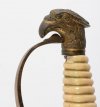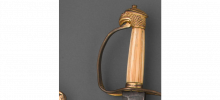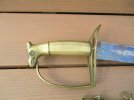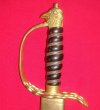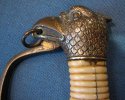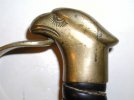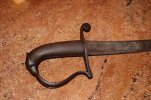- Joined
- Jul 16, 2001
- Messages
- 283
Early 19thc. German hunting or short sword. Total length is 28.5 inches. Blade is 23 inches. Signed very small on right side of blade in cursive script "P. D. Luneschloss", "(PDL)" and on the left side is "Solingen," also in small fine cursive script. Bone grip (it looks like it is stacked, but it isn't. It is two pieces of bone with inscribed lines), engraving, dual fullers, iron cross guard and iron eagle head pommel, chain knuckle guard (missing a few links.) None of the worn engraving shows up in the photos but the blade is finely engraved for the first 9 inches, until the actual edges begin.
Does anyone have more (or different) information on this sword?
Or where I might find more information?
Also...where I might find a matching chain to complete or replace it.




Does anyone have more (or different) information on this sword?
Or where I might find more information?
Also...where I might find a matching chain to complete or replace it.




Last edited:


